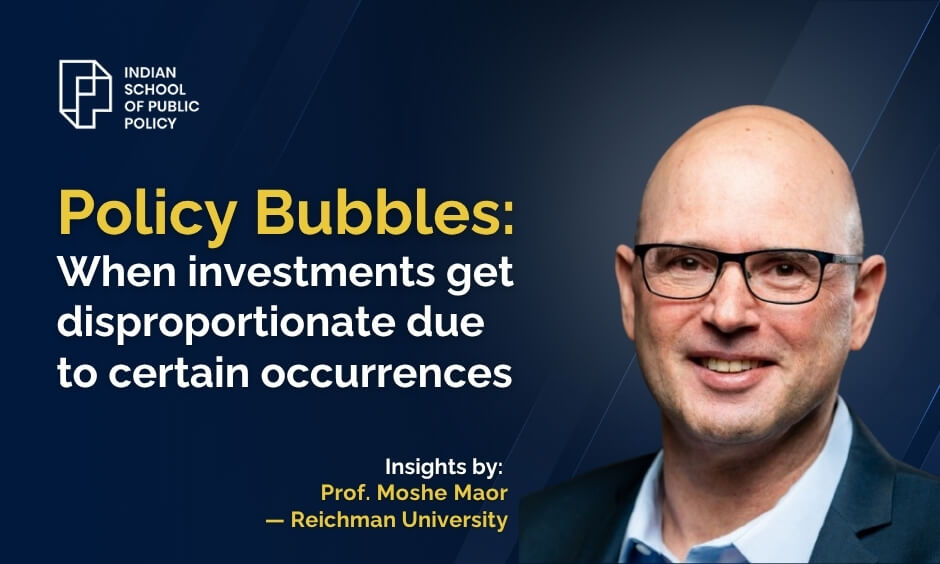Table of Contents
Policy Bubbles: When investments get disproportionate due to certain occurrences

The world of public policy often mirrors the excitement—and eventual crash—of financial markets. In a recent Friday Forum Guest Session, we were privileged to host Professor Moshe Maor of Reichman University, Israel ,who introduced us to the concept of the “Policy Bubble“: a phenomenon where policy investment becomes wildly disproportionate to the actual scope or evidence of a problem.
Professor Maor’s insights provided a critical framework for scholars to move beyond mere policy analysis to understand the anatomy of policy failure. “Key takeaways from his lecture include the following”:
The Anatomy of a Policy Bubble
A Policy Bubble forms when a policy problem is subject to Policy Overstatement, creating an “Acid Bubble” that, like an economic bubble, eventually deflates. This process is driven by several key forces:
1. Policy Overstatement and Disproportionality
A Policy Bubble is characterized by a disproportional policy perspective, where the perceived severity of a problem far outstrips the factual data.
Policy Bubble vs. Political Bubble: According to Professor Maor while an economic bubble is driven by investor enthusiasm and positive feedback mechanisms (e.g., the Railway Manias in Britain during the 1840s, a stock market bubble in the railway industry leading to widespread speculation), a political bubble is a temporary spike in attention around an issue. A Policy Bubble, however, is unique because it involves sustained, disproportionate Policy Investment—a significant allocation of public funds and resources—based on an overblown narrative.
2. The Mechanics of Capture
How does a small issue inflate into a massive bubble? Professor Maor highlighted three mechanisms of “capture” that fuel the disproportionate investment:
First, the Information Capture: Distorting the narrative by confusing different levels of evidence. As Professor Maor notes, “Fact is not data, and data are not evidence.” The perceived problem is inflated through emotional appeals and selective data.
Second, the Constitutional Capture & Culture Capture: Policy changes that become permanent, making it difficult to block such policy change. The bubble locks in place through irreversible institutional or cultural shifts.
Third, the Crime Policy Bubble (USA, 1991–2010): The classic example is the Crime Policy Bubble in the USA from 1991 to 2010. Fueled by the “tough on crime” narrative and public fear, this bubble led to massive, disproportionate investment in incarceration related activities. Conversely, Professor Maor noted the extreme disproportionality where, for example, only 10% of funding is designated to research on a disease, while much more is spent in other research activities, reflecting an imbalance in resource allocation.
The Temporal Dimension and Policy as Systematic Risk
Professor Maor urges analysts to detect the temporal dimension of policy change by tracing the emergency of the narrative. Bubbles have a lifecycle defined by human herding and the narrative foundation. Strong indicators of a bubble include a Policy Monopoly where debates are suppressed, and large-scale, irreversible investments are made (e.g., the potential for policy investment in Georgia and Ukraine following the 2007/2022 conflicts as a policy cover reaction governance).
The core takeaway is that the Policy Bubble constitutes a systematic risk, leading to a waste of money and resources, potentially giving rise to another set policy problems (where effectively if one problem decreases, other increases).
How Should the Government Respond?
Professor Maor outlined several proposed government responses to mitigate or manage policy bubbles, These include:
Risk Reduction (The “Wait and See”) Approach: Recognizing the possibility of a bubble and slowing the rate of investment in related areas.
Containment Approach: Mobilising independent agencies to introduce institutional constraints and save public money. This independence of agencies, however, must be real.
Bubble Pricking Approach: A proactive measure to deflate the bubble when the ethical cost-benefit analysis shows a great need to do so, a deliberate action to achieve a clear cut correction.
Professor Maor argues that a Policy Bubble can be good if it generates a necessary debate and political momentum, which tantamounts to Policy Entrepreneurship but only when managed responsibly through risk reduction and the communication of accurate information.
The path forward requires governments to evaluate their ‘Policy Mix’ and ensure that policy tools are designed with rational policy making synergies, rather than being driven by emotional, inflated narratives gained through developments such as social networks.
We thank Professor Maor for opening our eyes to the pervasive risk of policy bubbles that exist across segments, from crime to research. His works encourages us to be better, more rigorous guardians of public resources.



